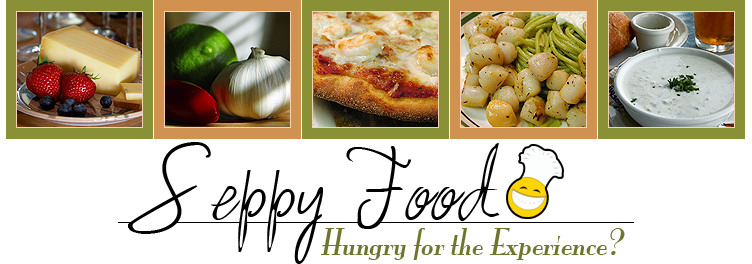Post by Marty (Seppy) on Jul 24, 2012 10:44:46 GMT -5
Summer Fruit
All year we’ve waited for those succulent sweets of summer – fruits. At last they’re here. Sweet blueberries, honeydew, nectarines, cantaloupe, mangos, watermelon, blackberries, lychee nuts, plums, raspberries… and tree-ripened peaches… every bite sends sweet juice dripping from the corners of your mouth and pooling in your palm before dripping down your arm. Believe it or not, some health-conscious foodies resist the delights of nature’s irresistible “sweets.” Why?
Individually packaged and delicious on their own, fruits are a treat any time. But when finessed into the culinary creations…who can resist dishes that combine traditional fruits into food from Marty. And then there are dishes like dishes using the less acknowledged fruits from Marty using less widely acknowledged fruits like tomatoes, peppers and corn. Fruits make the culinary creations of summer seem endless!
Essentially, fruits carry the seeds for the next generation of plants. But months before that can happen, the plant is pollinated, flowers bloom and specialization and flavoring of the edible fruits begins. So much flavor…so why resist?
The reason for resisting is twofold - too many calories and the blood sugar roller coast concern. Fruit, sweet in nature, creates these concerns because many people do not understand the different kinds of sugar and calories.
It is easy to eat too many calories from fruit when drinking the juice. A ½-cup serving of juice with breakfast or as a refreshment during the day only has 60 calories. But drinking fruit juice in place of water, can add up quickly. However, when eating the whole fruit, even when it is part of a dish has many merits that control the calories as well as the blood-sugar concern.
To understand these merits, resisters need to understand that all fruits (even those we call vegetables) have fiber and different amounts of the sugars glucose, sucrose, fructose and maltose. Sucrose (the same as table sugar) is a glucose molecule attached to a fructose molecule and maltose is two glucose molecules making them disaccharides. Disaccharides are broken down in digestion to their monosaccharide components of fructose and glucose. All single molecule sugars are then absorbed into the blood stream.
Glucose from fruit is the same as glucose in the blood. This has an immediate affect upon absorption. While fructose will eventually affect blood sugar, it will be delayed. And this lessens the effect on blood sugar.
To illustrate this affect, pure glucose is glycemic index of 100. This is the highest point of the glycemic scale with a subsequent plummet that can mirror this peak – a roller coaster ride to be avoided. A few fruits like watermelon (72) and pineapple (66) can cause similar affects when eaten by themselves, but with less intensity.
Other fruits have glycemic indices as low as 22, like cherries. Other fruits have a glycemic index a little higher but still well below that of glucose. Plums and peaches can range between a glycemic index in the low 20s to the mid 50s . Kiwi is between 47 and 58.
What is happening in the body to lowers the glycemic index of most fruits? Before fructose can affect the blood sugar it must first travel through the blood stream from the small intestine where it is absorbed to the liver where it is metabolized into the usable energy glucose. This takes time and energy as well. This delay and energy requirement, means that the caloric impact of fructose is lower than that of glucose.
So, what’s the buzz around high fructose corn syrup (HFCS)? In and of itself, high fructose corn syrup poses no health hazard. But because it’s in so many processed foods supplying a concentrated amount of calories, it can derail your weight. Another contributing factor is that HFCS lacks fiber (and other redeeming nutrients).
Fiber also delays in the impact of sugars on the blood by slowing the digestion and absorption of all the sugars in fruit. This gradual absorption of single sugar molecules (monosaccharides) coupled with the time consuming conversion of fructose to glucose lessens the chance that the body will have too much sugar in the blood at any given time. Only so much blood sugar can be used for energy or stored as glycogen. The excess gets stored as fat.
Stick to the natural recipe for pure sweet pleasure.
Add recipe.
Corn Chowder
written by Libby Mills MS, RD, LDN
posted by me Marty O.
All year we’ve waited for those succulent sweets of summer – fruits. At last they’re here. Sweet blueberries, honeydew, nectarines, cantaloupe, mangos, watermelon, blackberries, lychee nuts, plums, raspberries… and tree-ripened peaches… every bite sends sweet juice dripping from the corners of your mouth and pooling in your palm before dripping down your arm. Believe it or not, some health-conscious foodies resist the delights of nature’s irresistible “sweets.” Why?
Individually packaged and delicious on their own, fruits are a treat any time. But when finessed into the culinary creations…who can resist dishes that combine traditional fruits into food from Marty. And then there are dishes like dishes using the less acknowledged fruits from Marty using less widely acknowledged fruits like tomatoes, peppers and corn. Fruits make the culinary creations of summer seem endless!
Essentially, fruits carry the seeds for the next generation of plants. But months before that can happen, the plant is pollinated, flowers bloom and specialization and flavoring of the edible fruits begins. So much flavor…so why resist?
The reason for resisting is twofold - too many calories and the blood sugar roller coast concern. Fruit, sweet in nature, creates these concerns because many people do not understand the different kinds of sugar and calories.
It is easy to eat too many calories from fruit when drinking the juice. A ½-cup serving of juice with breakfast or as a refreshment during the day only has 60 calories. But drinking fruit juice in place of water, can add up quickly. However, when eating the whole fruit, even when it is part of a dish has many merits that control the calories as well as the blood-sugar concern.
To understand these merits, resisters need to understand that all fruits (even those we call vegetables) have fiber and different amounts of the sugars glucose, sucrose, fructose and maltose. Sucrose (the same as table sugar) is a glucose molecule attached to a fructose molecule and maltose is two glucose molecules making them disaccharides. Disaccharides are broken down in digestion to their monosaccharide components of fructose and glucose. All single molecule sugars are then absorbed into the blood stream.
Glucose from fruit is the same as glucose in the blood. This has an immediate affect upon absorption. While fructose will eventually affect blood sugar, it will be delayed. And this lessens the effect on blood sugar.
To illustrate this affect, pure glucose is glycemic index of 100. This is the highest point of the glycemic scale with a subsequent plummet that can mirror this peak – a roller coaster ride to be avoided. A few fruits like watermelon (72) and pineapple (66) can cause similar affects when eaten by themselves, but with less intensity.
Other fruits have glycemic indices as low as 22, like cherries. Other fruits have a glycemic index a little higher but still well below that of glucose. Plums and peaches can range between a glycemic index in the low 20s to the mid 50s . Kiwi is between 47 and 58.
What is happening in the body to lowers the glycemic index of most fruits? Before fructose can affect the blood sugar it must first travel through the blood stream from the small intestine where it is absorbed to the liver where it is metabolized into the usable energy glucose. This takes time and energy as well. This delay and energy requirement, means that the caloric impact of fructose is lower than that of glucose.
So, what’s the buzz around high fructose corn syrup (HFCS)? In and of itself, high fructose corn syrup poses no health hazard. But because it’s in so many processed foods supplying a concentrated amount of calories, it can derail your weight. Another contributing factor is that HFCS lacks fiber (and other redeeming nutrients).
Fiber also delays in the impact of sugars on the blood by slowing the digestion and absorption of all the sugars in fruit. This gradual absorption of single sugar molecules (monosaccharides) coupled with the time consuming conversion of fructose to glucose lessens the chance that the body will have too much sugar in the blood at any given time. Only so much blood sugar can be used for energy or stored as glycogen. The excess gets stored as fat.
Stick to the natural recipe for pure sweet pleasure.
Add recipe.
Corn Chowder
written by Libby Mills MS, RD, LDN
posted by me Marty O.






 realy tasty! (im noob of food baking so i came here)
realy tasty! (im noob of food baking so i came here) , just smiley testing agian
, just smiley testing agian seppy, how to make very good spaghety..?
seppy, how to make very good spaghety..? 
